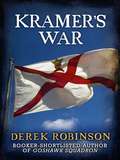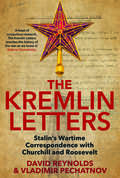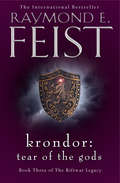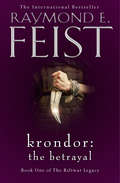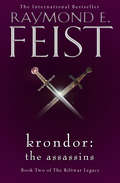- Table View
- List View
The Kosovo Tragedy: The Human Rights Dimensions
by Ken BoothThe 1999 conflict in Kosovo is seen as being as significant for international affairs as the pulling down of the Berlin Wall, because of the centrality of human rights in the build-up, conduct and aftermath of the war. This volume is an attempt to explore this human rights tragedy.
Kramer's War
by Derek RobinsonJersey, 1944. Lieutenant Earl Kramer, sole survivor of a ditched USAF bomber, crawls out of the sea one night and cuts the throat of a German sentry. Big mistake. Jersey is under Nazi occupation, and the lives of its inhabitants depend on an uneasy co-existence with their oppressors. Though Kramer's motives were entirely patriotic, to the islanders he presents a terrifying risk to their very survival. But to Kramer, a man governed by an overriding sense of duty, this stronghold of Hitler's armies proves too irresistible a target to ignore... Kramer's War is a powerful novel about the savagery of war, from the bestselling and Booker-shortlisted author of Goshawk Squadron.
Krauss-Maffei Leopard 1- Main Battle Tank (large print)
by RnibThis is an image of a tank seen from the side. There is a locator dot shown, which will be at the top left of the page when the image is the correct way up. The image is in the centre and a scale in metres on the bottom of the page. The front of the tank is on the left of the page and the back on the right of the page. The rotating gun turret is in the top left of the image. It is facing backwards pointing to the right. On the left it has four mortar launchers on the side and two aerials on the top. To the right of the turret is the gun barrel with the muzzle on the right of the page. The main body of the tank has an engine vent on the right. In the middle of the body area in a horizontal line are four track guard flaps which hide the upper part of the track. At the bottom of the image there eight wheels with a ninth spiky drive wheel on the right and the track of the vehicle running upwards at the left and right.
Krauss-Maffei Leopard 1- Main Battle Tank (UEB contracted)
by RnibThis is an image of a tank seen from the side. There is a locator dot shown, which will be at the top left of the page when the image is the correct way up. The image is in the centre and a scale in metres on the bottom of the page. The front of the tank is on the left of the page and the back on the right of the page. The rotating gun turret is in the top left of the image. It is facing backwards pointing to the right. On the left it has four mortar launchers on the side and two aerials on the top. To the right of the turret is the gun barrel with the muzzle on the right of the page. The main body of the tank has an engine vent on the right. In the middle of the body area in a horizontal line are four track guard flaps which hide the upper part of the track. At the bottom of the image there eight wheels with a ninth spiky drive wheel on the right and the track of the vehicle running upwards at the left and right.
Krauss-Maffei Leopard 1- Main Battle Tank (UEB uncontracted)
by RnibThis is an image of a tank seen from the side. There is a locator dot shown, which will be at the top left of the page when the image is the correct way up. The image is in the centre and a scale in metres on the bottom of the page. The front of the tank is on the left of the page and the back on the right of the page. The rotating gun turret is in the top left of the image. It is facing backwards pointing to the right. On the left it has four mortar launchers on the side and two aerials on the top. To the right of the turret is the gun barrel with the muzzle on the right of the page. The main body of the tank has an engine vent on the right. In the middle of the body area in a horizontal line are four track guard flaps which hide the upper part of the track. At the bottom of the image there eight wheels with a ninth spiky drive wheel on the right and the track of the vehicle running upwards at the left and right.
The Kremlin Letters: Stalin's Wartime Correspondence with Churchill and Roosevelt
by David Reynolds Vladimir PechatnovA penetrating account of the dynamics of World War II’s Grand Alliance through the messages exchanged by the "Big Three" Stalin exchanged more than six hundred messages with Allied leaders Churchill and Roosevelt during the Second World War. In this riveting volume—the fruit of a unique British-Russian scholarly collaboration—the messages are published and also analyzed within their historical context. Ranging from intimate personal greetings to weighty salvos about diplomacy and strategy, this book offers fascinating new revelations of the political machinations and human stories behind the Allied triumvirate. Edited and narrated by two of the world’s leading scholars on World War II diplomacy and based on a decade of research in British, American, and newly available Russian archives, this crucial addition to wartime scholarship illuminates an alliance that really worked while exposing its fractious limits and the issues and egos that set the stage for the Cold War that followed.
Kremlin Winter: Russia and the Second Coming of Vladimir Putin
by Robert ServiceVladimir Putin has dominated Russian politics since Boris Yeltsin relinquished the presidency in his favour in May 2000. He served two terms as president, before himself relinquishing the post to his prime minister, Dimitri Medvedev, only to return to presidential power for a third time in 2012. Putin’s rule, whether as president or prime minister, has been marked by a steady increase in domestic repression and international assertiveness. Despite this, there have been signs of liberal growth and Putin – and Russia – now faces a far from certain future.In Kremlin Winter, Robert Service, acclaimed biographer of Lenin, Stalin and Trotsky and one of our finest historians of modern Russia, brings his deep understanding of that country to bear on the man who leads it. He reveals a premier who cannot take his supremacy for granted, yet is determined to impose his will not only on his closest associates but on society at large. It is a riveting insight into power politics as Russia faces a blizzard of difficulties both at home and abroad.
Kriegsmarine Auxiliary Cruisers (New Vanguard)
by Ian Palmer Gordon WilliamsonDespite being relatively unknown compared to famous ships like Graf Spee or Bismarke, or the more famous U-boats, the Auxiliary Cruisers were immensely successful, not only in the number of enemy ships they sank, but in the resources which were tied up trying to track them down. The Royal Navy's auxiliary cruisers tended to be merchant vessels used to protect convoys from attack. The German Auxiliary Cruisers, however, heavily armed and usually carried torpedo tubes as well as guns and even sometimes their own aircraft. These ships were aggressive predators, searching the sea lanes for unsuspecting enemy merchants, and were not only capable of destroying enemy merchant ships, but also of defending themselves against well-armed enemy warships. This book looks at the specifications and designs of the 11 Auxiliary Cruisers, as well as their combat histories, their eventual fates, and the careers of some of the most famous commanders.
Kriegsmarine Auxiliary Cruisers (New Vanguard)
by Gordon WilliamsonDespite being relatively unknown compared to famous ships like Graf Spee or Bismarke, or the more famous U-boats, the Auxiliary Cruisers were immensely successful, not only in the number of enemy ships they sank, but in the resources which were tied up trying to track them down. The Royal Navy's auxiliary cruisers tended to be merchant vessels used to protect convoys from attack. The German Auxiliary Cruisers, however, heavily armed and usually carried torpedo tubes as well as guns and even sometimes their own aircraft. These ships were aggressive predators, searching the sea lanes for unsuspecting enemy merchants, and were not only capable of destroying enemy merchant ships, but also of defending themselves against well-armed enemy warships. This book looks at the specifications and designs of the 11 Auxiliary Cruisers, as well as their combat histories, their eventual fates, and the careers of some of the most famous commanders.
Kriegsmarine Coastal Forces (New Vanguard)
by Gordon WilliamsonAlthough often overlooked in favour of the U-boats or battleships, the vast majority of the Kriegsmarine was formed of the smaller vessels of the coastal forces. These ships and boats, which included minesweepers, torpedo boats, patrol boats, and blockade breakers, gave crucial service to Germany during the war, and many continued serving for decades after the surrender in such tasks as clearing minefields. Also included in these forces was Hitler's yacht, the Ostwind. This book reveals the history of the vessels that formed the backbone of the Kriegsmarine, and combines fascinating anecdotes, detailed technical information, and full-colour artwork.
Kriegsmarine Coastal Forces (New Vanguard #151)
by Gordon WilliamsonAlthough often overlooked in favour of the U-boats or battleships, the vast majority of the Kriegsmarine was formed of the smaller vessels of the coastal forces. These ships and boats, which included minesweepers, torpedo boats, patrol boats, and blockade breakers, gave crucial service to Germany during the war, and many continued serving for decades after the surrender in such tasks as clearing minefields. Also included in these forces was Hitler's yacht, the Ostwind. This book reveals the history of the vessels that formed the backbone of the Kriegsmarine, and combines fascinating anecdotes, detailed technical information, and full-colour artwork.
Kriegsmarine U-boats 1939–45 (New Vanguard)
by Ian Palmer Gordon WilliamsonThis, the first of two volumes on Germany's World War II U-boats, traces their development from the early U-boats of the Kaiser's Navy, the prohibition on Germany having U-boats following the Armistice in 1918 and the subsequent Treaty of Versailles, the secret development of U-boats using a 'cover-firm' in Holland, culminating in the formation of the 1st U-boat Flotilla in 1935 with the modern Type II. The operational history section includes examples from the Classes Type VIIA, Type VIIB, VIID, VIIE and VIIF before concentrating on the mainstay of the U-boat arm, the Type VIIC. Comparisons are also made with the standard allied submarines, their strengths, weaknesses and U-boat tactics.
Kriegsmarine U-boats 1939–45 (New Vanguard)
by Ian Palmer Gordon WilliamsonThis title follows from New Vanguard 51: Kriegsmarine U-boats 1939–45 (1) and charts the continuing development of the U-boat in German service, including the evolution of the Type IX as a long range 'cruiser' intended for solo operations in distant waters. Also covered is the revolutionary Type XXI, conceived of in 1942 and launched in April 1944, the first true submarine rather than submersible, whose arrival was just too late to influence the war. Other vessels covered are the Type XXIII, a small vessel armed with only two torpedoes but technically highly advanced, and the Type X minelayers, which were rarely used in their intended role and more often used as supply boats.
Kriegsmarine U-boats 1939–45 (New Vanguard #55)
by Gordon Williamson Mr Ian PalmerThis title follows from New Vanguard 51: Kriegsmarine U-boats 1939–45 (1) and charts the continuing development of the U-boat in German service, including the evolution of the Type IX as a long range 'cruiser' intended for solo operations in distant waters. Also covered is the revolutionary Type XXI, conceived of in 1942 and launched in April 1944, the first true submarine rather than submersible, whose arrival was just too late to influence the war. Other vessels covered are the Type XXIII, a small vessel armed with only two torpedoes but technically highly advanced, and the Type X minelayers, which were rarely used in their intended role and more often used as supply boats.
Kriegsmarine U-boats 1939–45 (New Vanguard)
by Gordon Williamson Mr Ian PalmerThis, the first of two volumes on Germany's World War II U-boats, traces their development from the early U-boats of the Kaiser's Navy, the prohibition on Germany having U-boats following the Armistice in 1918 and the subsequent Treaty of Versailles, the secret development of U-boats using a 'cover-firm' in Holland, culminating in the formation of the 1st U-boat Flotilla in 1935 with the modern Type II. The operational history section includes examples from the Classes Type VIIA, Type VIIB, VIID, VIIE and VIIF before concentrating on the mainstay of the U-boat arm, the Type VIIC. Comparisons are also made with the standard allied submarines, their strengths, weaknesses and U-boat tactics.
Krithia: The Forgotten Anzac Battle of Gallipoli
by Mat McLachlanThe Second Battle of Krithia has existed largely in the shadows of the bigger Gallipoli story. It is, however, one of the most poignant and tragic tales of World War I. The fascinating story has been brought to light at last by bestselling military historian Mat McLachlan, author of The Cowra Breakout.In May 1915 during World War I, British units tried to capture the village of Krithia on the southern tip of the Gallipoli peninsula. Australian and New Zealand units were sent to reinforce the British. On 8 May, the Anzac troops took part in a bloody battle near Krithia. Advancing across a featureless plain in broad daylight, with no idea where the Turkish defenders were, the Anzacs came under a hail of machine-gun and rifle fire. The Australians managed to advance, but got nowhere near the village and dug in well short of their objective. The New Zealanders on their left fared no better. By the end of the day, over 1800 Anzac troops had been killed or wounded.Supported by first-hand accounts and oral history, Krithia features the stories of a number of Australians, New Zealanders and Turks - some who survived, some who didn't. The battle of Krithia is a tale of bravery and sacrifice, and a vivid portrait of men doing their best under hellish conditions. It's a great Australian story that hasn't been told - until now.
Krondor: Tear Of The Gods (The Riftwar Legacy #3)
by Raymond E. FeistBOOK THREE OF THE RIFTWAR LEGACY The final instalment of Feist’s spellbinding Krondor adventure. Now in a brilliant new livery. ‘Feist writes fantasy of epic scope, fast-moving action and vivid imagination’ Washington Post
Krondor: The Betrayal (The Riftwar Legacy #1)
by Raymond E. FeistBOOK ONE OF THE RIFTWAR LEGACY Continuing on from Feist’s bestselling Riftwar Saga comes a spellbinding adventure. Now in a brilliant new livery. ‘Tons of intrigue and action’ Publishers Weekly
Krondor: The Assassins (The Riftwar Legacy #2)
by Raymond E. FeistBOOK TWO OF THE RIFTWAR LEGACY Continuing on from Feist’s bestselling Riftwar Saga comes a spellbinding adventure. Now in a brilliant new livery. ‘Feist writes fantasy of epic scope, fast-moving action and vivid imagination’ Washington Post
Kropotkin, Read, and the Intellectual History of British Anarchism: Between Reason and Romanticism
by M. AdamsAlthough marginal as a political force, anarchist ideas developed in Britain into a political tradition. This book explores this lost history, offering a new appraisal of the work of Kropotkin and Read, and examining the ways in which they endeavoured to articulate a politics fit for the particular challenges of Britain's modern history.
The Kuban 1943: The Wehrmacht's last stand in the Caucasus (Campaign)
by Robert Forczyk Steve Noon Nikolai BogdanovicIn the summer of 1942, the Wehrmacht invaded the Caucasus in order to overrun critical oil production facilities at Maikop, Grozny and Baku. However, the Red Army stopped the Germans short of their objectives and then launched a devastating winter counteroffensive that encircled them at Stalingrad. Consequently, Hitler grudgingly ordered an evacuation from the Caucasus, but ordered 17. Armee to fortify the Kuban bridgehead and hold it at all costs in order to leave open the possibility of future offensives. On the other side, the Soviet Stavka ordered the North Caucasus Front and the Black Sea Fleet to eliminate the Kuban bridgehead as soon as possible. The stage was set for a contest between an immovable object and an unstoppable force. With the help of stunning specially commissioned artwork, this book tells the enthralling story of the impressive but strategically foolish German stand at Kuban, which tied down seven Soviet armies in a sideshow battle of attrition, which the Soviets dubbed 'the Kuban meat grinder.'
The Kuban 1943: The Wehrmacht's last stand in the Caucasus (Campaign #318)
by Robert Forczyk Steve Noon Nikolai BogdanovicIn the summer of 1942, the Wehrmacht invaded the Caucasus in order to overrun critical oil production facilities at Maikop, Grozny and Baku. However, the Red Army stopped the Germans short of their objectives and then launched a devastating winter counteroffensive that encircled them at Stalingrad. Consequently, Hitler grudgingly ordered an evacuation from the Caucasus, but ordered 17. Armee to fortify the Kuban bridgehead and hold it at all costs in order to leave open the possibility of future offensives. On the other side, the Soviet Stavka ordered the North Caucasus Front and the Black Sea Fleet to eliminate the Kuban bridgehead as soon as possible. The stage was set for a contest between an immovable object and an unstoppable force. With the help of stunning specially commissioned artwork, this book tells the enthralling story of the impressive but strategically foolish German stand at Kuban, which tied down seven Soviet armies in a sideshow battle of attrition, which the Soviets dubbed 'the Kuban meat grinder.'
Kublai Khan
by John ManIn Xanadu did Kubla KhanA stately pleasure dome decreeKublai Khan lives on in the popular imagination thanks to these two lines of poetry by Coleridge. But the true story behind this legend is even more fantastic than the poem would have us believe. He inherited the second largest land empire in history from his grandfather, Genghis Khan. He promptly set about extending this into the biggest empire the world has ever seen, extending his rule from China to Iraq, from Siberia to Afghanistan. His personal domain covered sixty-percent of all Asia, and one-fifth of the world's land area. The West first learnt of this great Khan through the reports of Marco Polo. Kublai had not been born to rule, but had clawed his way to leadership, achieving power only in his 40s. He had inherited Genghis Khan's great dream of world domination. But unlike his grandfather he saw China and not Mongolia as the key to controlling power and turned Genghis' unwieldy empire into a federation. Using China's great wealth, coupled with his shrewd and subtle government, he created an empire that was the greatest since the fall of Rome, and shaped the modern world as we know it today. He gave China its modern-day borders and his legacy is that country's resurgence, and the superpower China of tomorrow.
Kulikovo 1380: The battle that made Russia (Campaign)
by Darren Tan Mark Galeotti Bounford.com Bounford.com Paul KimeThe 14th-century Mongol conquest of the Rus' – the principalities of Russia – was devastating and decisive. Cities were lain waste, new dynasties rose and for a hundred years the Russians were under unquestioned foreign rule. However, the Mongols were conquerors rather than administrators and they chose to rule through subject princes. This allowed the Rurikid dynastic princes of Moscow to rise with unprecedented speed. With the famed 'Mongol Yoke' loosening, Grand Prince Dmitri of Moscow saw in this an unparalleled opportunity to rebel. On 7 September 1380 his 60,000 troops crossed the Don to take the battle to Mamai's 125,000, which included Armenian and Cherkessk auxiliaries and Genoese mercenaries. Using specially commissioned artwork, this is the engrossing story of the victory that heralded the birth of Russian statehood.
Kulikovo 1380: The battle that made Russia (Campaign #332)
by Darren Tan Mark Galeotti Bounford.com Bounford.com Paul KimeThe 14th-century Mongol conquest of the Rus' – the principalities of Russia – was devastating and decisive. Cities were lain waste, new dynasties rose and for a hundred years the Russians were under unquestioned foreign rule. However, the Mongols were conquerors rather than administrators and they chose to rule through subject princes. This allowed the Rurikid dynastic princes of Moscow to rise with unprecedented speed. With the famed 'Mongol Yoke' loosening, Grand Prince Dmitri of Moscow saw in this an unparalleled opportunity to rebel. On 7 September 1380 his 60,000 troops crossed the Don to take the battle to Mamai's 125,000, which included Armenian and Cherkessk auxiliaries and Genoese mercenaries. Using specially commissioned artwork, this is the engrossing story of the victory that heralded the birth of Russian statehood.

